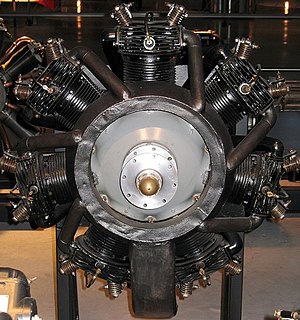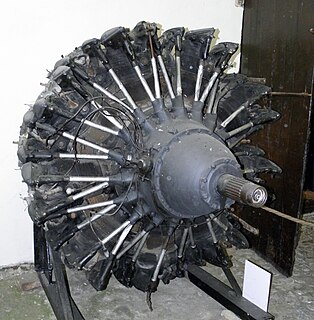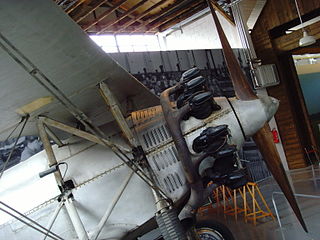
The Jumo 222 was a German high-power multiple-bank in-line piston aircraft engine from Junkers, designed under the management of Ferdinand Brandner of the Junkers Motorenwerke.

The BMW 132 was a nine-cylinder radial aircraft engine produced by BMW starting in 1933.

The Lycoming XR-7755 was the largest piston aircraft engine ever built in the United States, with 36 cylinders totaling about 7,750 in³ (127 L) of displacement and a power output of 5,000 horsepower (3,700 kilowatts). It was originally intended to be used in the "European bomber" that eventually emerged as the Convair B-36. Only two examples were built before the project was terminated in 1946.

The Armstrong Siddeley Cheetah is a seven-cylinder British air-cooled aircraft radial engine of 834 cu in capacity introduced in 1935 and produced until 1948. Early variants of the Cheetah were initially known as the Lynx Major.

The Armstrong Siddeley Jaguar was an aircraft engine developed by Armstrong Siddeley. The Jaguar was a petrol-fuelled air-cooled 14-cylinder two-row radial engine design. The Jaguar III was first used in 1923, followed in 1925 by the Jaguar IV and in 1927 by the Jaguar VI. In 1925 the Jaguar became the first production aero engine incorporating a geared supercharger.

The Armstrong Siddeley Panther was a 27-litre 14-cylinder twin-row air-cooled radial aero engine developed by Armstrong Siddeley. It was originally named the Jaguar Major.

The Warner Scarab is an American seven-cylinder radial aircraft engine, that was manufactured by the Warner Aircraft Corporation of Detroit, Michigan in 1928 through to the early 1940s. In military service the engine was designated R-420.

The Hispano-Suiza 14AB, a.k.a. Hispano-Suiza Type 80, was a 14-cylinder twin-row air-cooled radial engine. In 1929 the Hispano-Suiza company bought a license to produce the Wright Whirlwind engine. The technology from that engine was used to produce a number of different radial engines with greater displacements, power, and number of cylinders.

The Gnome-Rhône 7K Titan Major was a seven-cylinder 370 hp (270 kW) air-cooled radial engine, that started life as an enlarged Gnome-Rhône 5K with two extra cylinders.

The Armstrong Siddeley Tiger was a British 14-cylinder air-cooled aircraft radial engine developed by Armstrong Siddeley in the 1930s from their Jaguar engine. The engine was built in a number of different versions but performance and dimensions stayed relatively unchanged. The Tiger VIII was the first British aircraft engine to use a two-speed supercharger.

The Wright R-2160 Tornado was an experimental 42-cylinder, 7-bank liquid-cooled inline radial aircraft engine. It was proposed in 1940 with 2,350 hp (1,752 kW) for experimental aircraft such as the Lockheed XP-58 Chain Lightning, Vultee XP-68 Tornado, and the Republic XP-69.

The Kinner B-5 was a popular five cylinder American radial engine for light general and sport aircraft of the 1930s.

The Alfa Romeo 135 Tornado was an Italian 18-cylinder radial engine designed by Giustino Cattaneo in 1934–1935.
The BMW X was a small five-cylinder radial engine for sport and training aircraft. Although this engine proved successful at several large-scale events in 1930, including that year's round-Europe flight, only a few were built.

The Walter Regulus was a Czechoslovakian five-cylinder, air-cooled radial engine for powering light aircraft that first ran in 1934. The engine produced 186 kW.

The SNECMA 14R was a 14-cylinder two-row air-cooled radial engine developed in France just prior to the start of World War II from the Gnome-Rhône 14N. The 14N radial engine was itself an improved version of the popular pre-war Gnome-Rhône 14K Mistral Major series; designed and manufactured by Gnome et Rhône, a major French aircraft engine manufacturer whose origins pre-date the First World War.

The Walter Sagitta was a Czechoslovakian, air-cooled, inverted V-12 engine that first ran in 1937. With a displacement of 18.4 litres, it produced up to 373 kW at 2,500 rpm.

The Piaggio P.XII is an Italian 18-cylinder radial aircraft engine developed in the 1930s by Rinaldo Piaggio S.p.A.. The engine was used in many Italian aircraft from 1940 until the end of World War II. An up-rated version was produced as the Piaggio P.XXII.

The Piaggio Stella P.VII was the first P series aircraft engine produced by Rinaldo Piaggio S.p.A.. Based on its experience license-producing the Gnome-Rhône 7K, Piaggio sold the engine to be used on a wide range of Italian aircraft before and during World War II, including the record-breaking Caproni Ca.133.
The Mathis Vega 42 was a 42-cylinder 6-bank in-line radial piston engine, designed and built in France, by Société Mathis Aviation in the late 1930s, with development continuing during and after WWII.

















